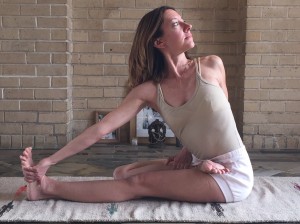
by guest blogger Holly Walck Kostura, certified Iyengar Yoga teacher
“Alignment is enlightenment.” —B.K.S. Iyengar
For more than 10 years now, I have been teaching Iyengar yoga, the method of hatha yoga developed by world-renowned yoga master B.K.S. Iyengar. Affectionately known as Guruji to his pupils, Iyengar was renowned for his majestic demonstrations of yoga asanas (postures), but his true brilliance was in how he wove the philosophy of yoga into his teaching, bringing it to the forefront and raising the profile of hatha yoga in India and throughout the world.
Classically, hatha yoga, regardless of tradition, uses postures; techniques for controlling prana, or energy; and other practices designed to purify the body and the mind, uncovering the light of the soul. The hallmarks of Iyengar yoga are attention to alignment, specific sequencing of postures, the use of props and modifications, and timings (staying in the pose for longer periods of time). These four keys unlock the door between the body, the mind, the breath, the senses, and the intellect and the soul.
In the next few blogs we are going to “unpack” the four hallmarks of Iyengar yoga and learn how they relate to the whole of yoga.
Attention to alignment is the technique used in Iyengar yoga to take a scattered, outgoing mind, bring it to a state of one-pointed attention, and draw it inward toward the Source. Of course, this way of practicing has a healthy effect on the physical body, including the healing of current injuries and conditions and the prevention of future ones; this is ahimsa, or “non-violence.” But perhaps even more important is the effect that paying attention to the alignment of our physical body has on the mind. In his Light on the Yoga Sutras of Patanjali, Iyengar tells us the following:
The internal measuring and balancing process is in some respects the key to why yoga practice actually works, why it has mechanical power to revolutionize our whole being. It is why Asana [posture] is not gymnastics, why Pranayama [restraint of life force energy] is not deep breathing, why Dhyana [meditation] is not self-induced trance, why Yama [personal ethics] is not just morality.
The following sequence opens with a warming vinyasa called Salutations to the Sun and then flows into a more advanced version of that vinyasa. It then moves into a sequence that includes the same key alignment points, practiced repeatedly, beginning with postures that are easier (reclining) and progressing into ones that become more and more challenging (standing, then balancing). It ends with a reclining, resting pose.
Remember to focus on the key alignment points repeated throughout the sequence and observe if your mind is able to penetrate more deeply into your embodiment. Follow the instructions for the breath given in each video and watch how the mind responds.
Alignment Is Enlightenment: A Yoga Sequence for the Hips and Groin
Salutations to the Sun (Surya Namaskarasana), classic and advanced
Reclining Hand-to-Big-Toe Pose (Supta Padangusthasana II), variations
Extended Triangle Pose (Utthita Trikonasana), from a variation of Extended Side Angle Pose (Utthita Parsvakonasana)
Tree Pose (Vrksasana)
The Infinite Being Within Pose (Anantasana)
Reclining Hero’s Pose (Supta Virasana)
As always, end with a deep Relaxation Pose (Savasana).
 Holly Walck Kostura uses the healing practices of Ayurveda and Iyengar Yoga to secure her to the core of her being. Combining her bachelor’s degree in nursing with her certification in Iyengar Yoga gives her the ability to approach her students from a place of wholeness and infuse her yoga classes with a unique flavor. Find her online at yogawithholly.com.
Holly Walck Kostura uses the healing practices of Ayurveda and Iyengar Yoga to secure her to the core of her being. Combining her bachelor’s degree in nursing with her certification in Iyengar Yoga gives her the ability to approach her students from a place of wholeness and infuse her yoga classes with a unique flavor. Find her online at yogawithholly.com.




No comments yet.